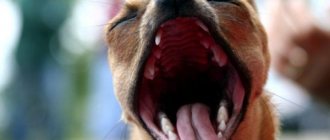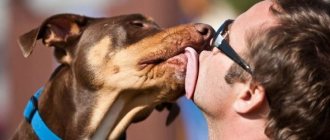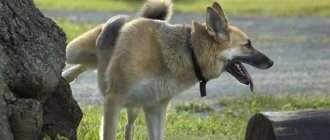Surely you have noticed that often our dogs lay their heads on the wall, which is quite rare and means that something is happening to the animal, although there is something else with which we can help ourselves find out if something is happening to our a dog - if it starts walking in a circle .
First of all, if a dog starts doing this, we need to see if this situation has anything to do with some reaction to a factor external to him, for example, if he is chasing something, if he is looking at a ceiling fan . or something similar. If your dog is walking in circles without any outside intervention then you should seek help from your veterinarian, these are some of the reasons why your dog is walking in circles.
You should keep in mind that this attitude when he is an adult may not be as unsettling as when he is a puppy. There are actually several reasons why an adult dog might roll over and bite its tail. And this:
Main reasons
If your dog is walking in circles without any intervention, you should seek help from your veterinarian. These are some of the reasons why your dog is walking in circles.
Healthcare
Take your dog to the vet to rule out any health problems, as if your dog is in pain, he may walk in circles to signal discomfort . Some diseases that our dog may suffer from are ear infections, eye problems or nervous disorders.
Old age
Like humans, older dogs also suffer from dementia , which can cause confusion or forgetfulness. The dog may then walk in circles as if lost, stare at doors or corners of the house, and exhibit personality changes.
You may forget where the food is, where the water is, where to pee or poop, as older dogs need to go to the vet more often to make sure their health is good, so make sure to take good care of your senior dog.
Article topic:
Common Problems in Older Dogs
Compulsive behavior
Many dogs experience compulsions to do certain things, and walking in circles is one of them. This behavior may be caused by loud noises, unexpected situations, or fear. even separation anxiety can contribute to this as well.
When your dog exhibits this behavior, try removing what is causing him stress or changing the environment. Try to distract him with a toy or something to eat and don't pet him or "comfort" him, as you will reinforce this behavior and he will see that every time he does it, he gets a prize.
Realize
Exercise is essential for a dog's mental and physical health, as Dogs who don't get enough exercise may start walking in circles to relieve frustration.
Consider taking him to a kennel to spend a few days a week playing with other dogs and expending energy, and remember not to fight with your dog when he starts walking in circles, as this behavior is his way of telling you what is not there is nothing wrong with him.
Anxiety
All these behavioral conflicts are included in the concept of anxiety, which is one of the main reasons why our dog turns on itself.
If your dog is overly anxious, it is likely that you will notice other problems in his behavior. , which usually results in constant nipping of objects in the house, such as furniture, or you may hear them bark excessively.
This behavior can also have a solution if we extend their walks as much as possible so that the dogs get more exercise and thus release all the tension and stress to cope with the situation at home without much worry.
Article topic:
What happens if you don't walk your dog?
His race
Among the many aspects that can lead to such strange behavior in your dog, you should also consider that every breed has similar behavioral parameters and this could be the main reason for the circular turns that your dog makes.
This means that dogs of certain breeds tend to have a certain predisposition towards these behaviors. , among which we can highlight the German Shepherds, which, in addition to being known for the fact that most of their individuals usually spin in circles, are also known for making large holes.
Another breed that tends to have similar genetic characteristics is the Bull Terrier, but in this particular case they tend to travel a wider route in their circles and always at great speed. Psychological reasons
When a dog performs this behavior, at a certain point he will end up internalizing it, losing understanding of why he is doing it. In other words, he does it as usual in it , but without any relation to the research or the fact of looking for something specific. The animal then develops a tic: although this is not a bad thing, it can become an unwanted habit, especially if it begins to harm itself.
How often does this behavior occur? Well, this can happen when the dog lacks attention, that is, when he is bored, locked in all the time, stressed or anxious, has no stimulation, or is simply not playing. In such cases , it becomes an option for them to do something different.
The problem is that in many cases he can hurt himself or seriously injure himself by grabbing his tail. You might even break it. Therefore, experts recommend that if this habit is unusual, the best thing you can do is to see an ethologist to eliminate it from your behavior.
Changing the situation
First, it is recommended to identify the situations that provoke your dog’s obsessive actions. Having identified them, they must be avoided, this will significantly reduce the level of anxiety and stress in the animal. However, it is impossible to avoid situations that frustrate the dog, such as a thunderstorm, a smell that frightens the animal, or a certain type of noise. Special training as part of behavior therapy will help the animal learn to react differently to a situation that cannot be prevented. Thanks to training, the level of anxiety will significantly decrease, which will lead to stabilization of your pet’s psychological state.
Physical reasons
The dog's turning and biting its tail can also be physical. And in this case, it may be important because it will affect your health. And this is what some dogs, when they have problems with their anal glands, they develop this habit as a way to make their life easier (as they try to get to that area).
This can happen due to infections, intestinal parasites, etc. and among the symptoms, in addition to irritation and inflammation of the anal area, there will also be the appearance of itching. In fact, the image of a dog crawling on its butt may immediately come to mind. Or it could be because of the nasty fleas that nest in the area and create such a need to scratch that they end up biting to get to the area and calm down.
In these cases, it is advisable that you take him to a veterinarian so that he can evaluate what the problem is and the cause of its occurrence in order to eliminate the problem and get rid of this habit. Typically you will do a physical examination of the animal and also feel the tail area to see if anything is broken. You may also have blood tests, stool tests, or both.
The number of periods of hyperactivity decreases with age
This behavior is most common among puppies. Don't be alarmed if your pet experiences a hyperactive episode more than twice a day. Owners should not be alarmed if the number of such periods decreases with age.
This is a normal part of a dog's maturation process. Most say that the puppy is actually testing his limits and how much activity he can handle at that point in time. Additionally, an older dog will sometimes become hyperactive if it observes a puppy doing the same thing, presumably in an attempt to relive its youth.
On YouTube, on behalf of the rapper Morgenstern, they began to steal money from users
Most often, Russians turn to the prosecutor's office complaining about employers
Asymmetrical shoulder-length hair and a few more fashionable medium-length haircuts
External reasons
Have you seen your dog since the puppy turns around and bites its tail, and have you laughed? Have you done this several times and did you have the same reaction? Dogs go out of their way for their owners, meaning that if they can do something to make you happy, they will do it.
Thus, some dogs often equate this activity with something good and teach it as a ploy to get your attention. and at the same time make you smile or give him something in return (affection, treat, etc.). The risk of damaging the tail is very high. And even if it seems funny to you, you should take care of your physical health.
The solution is through an ethologist, because if an animal has made this behavior habitual for it, you need someone to correct the behavior if you cannot do it yourself.
Drug therapy
In cases where obsessive-compulsive disorder has developed over a long period of time, drug therapy is used. Drugs designed to treat obsessive-compulsive disorder in people have a certain effect. These are medicines containing clomipramine or fluoxetine. Typically, the effect of taking medications begins to appear only after a few weeks.
Isolated, drug treatment is ineffective; to achieve the desired result, it must be combined with elements of behavioral therapy.
Under no circumstances should you treat your dog on your own! Drug treatment should only be carried out under the supervision of a veterinarian!
Less relevant reasons
The fact that your dog is walking in circles shouldn't always get our attention. There are pets that can be seen with a good facial expression and are happy, but they also perform these types of movements, but this does not mean that it is something harmful, but rather a matter of normal behavior.
Of course, you already know how your dog behaves, and if you know he is healthy, but if he is at all a little nervous, it is quite possible that he is running in circles out of excitement because something is providing a certain stimulus.
This situation can be illustrated by the excitement that most dogs usually show when we go to throw a ball at him to fetch him. We will see that the stimulation this causes in the dog is such that it itself turns into anxiety and joy in interacting with you and playing.
This is very little
Just as we tell you that in old age, dog turning circles can be a cause of health problems, it should also be noted that if your puppy begins to reproduce itself, do not worry too much, it is not a bad thing, but your pet's play ability.
Small dogs usually have a playful reflex of chasing their tail, and they will turn this way and that way several times while trying to reach it. This is not pathological, and you can easily understand that this is a game.
Walking our dogs in circles means nothing wrong as long as it doesn't become repetitive enough to interfere with their lives.
How to provoke activity?
If you want to induce such activity in a well-trained dog, there are several simple methods. For example, you can command your dog to lie down several times quickly, causing him to lower his chest to the ground and rise again.
And remember that animals almost always become violent in this state. Therefore, causing these moments can be cruel to the pet.
What if my dog is older and walks in circles?
Walking in circles can go unnoticed at an early age when, as we mentioned earlier, everything is part of the game. But if your dog is older and walking in circles, this is certainly a well-known pathology called cognitive dysfunction syndrome.
To make you understand the close connection between this canine disease and aging dogs, we can point out that this disease is very similar to Alzheimer's disease, which people usually suffer from in old age, and the list of symptoms that our dogs suffer from. from a very long time. You can suffer from it, but one of the most common ones is circular movements.
Older dogs suffering from this disease cannot be cured because it is progressive and inherent with age. But there are various treatments, some of which are natural, such as changing the dog's daily routine to adapt it to better cope with the disease, and in other cases, the administration of certain medications is usually used.
Why won't my dog stop walking around the house?
You may find yourself in many situations where your loved one can't stop walking around your home. This, which was previously unusual behavior for him and now comes to your attention, can be caused by a variety of reasons , many of which are completely natural, but others may have to do with health or well-being problems that you need to treat.
That’s why we recommend that you first eliminate all doubts that you can eliminate on your own. . Make sure they are not walking around looking for an object that is blocked somewhere or hidden behind a piece of furniture, which usually causes them to look around.
If you find a problem there, then you have already cleared your doubts about the disease. But if turns around your home continue, it is recommended to visit a veterinarian to make an accurate diagnosis.
When should you be wary?
The first thing to understand is that spinning before bed is normal. Before domestication, wild dogs crushed grass under them or dug holes to shelter from the weather.
They speak about illness only when the animal begins to cut circles too long and too often. If there are no obvious incentives for such actions, sound the alarm. In such cases, the cause often lies in mental disorders or brain injuries. In addition to whirling, the condition is accompanied by:
catching and biting the tail;
prolonged pursuit of shadows or sunbeams;
licking or chewing the skin on the paws and tail;
long walking or running along the same route;
over-indulgence in one or more toys.
Due to the regular repetition of obsessive actions, your beloved pet forgets about food and water, depleting his body. Scratching appears on his body, fraught with secondary infection. If these symptoms appear, contact your veterinarian immediately. After examining the patient, he will be able to confirm suspicions or refute them by discovering physiological causes.
Possible diseases that are causing my dog to walk in circles
In addition to all the behavioral conflicts that we have mentioned, there are also other diseases or disorders that can cause your dog to walk in circles and these are the following:
- Brain injury
- Intracranial tumors
- Hydrocephalus
- Reactions to medications
- Poisoning
- My dog turns on and bites his tail
This is probably the situation you should be least concerned about because dogs tend to do this, especially if they are puppies and are in the process of exploring. In addition, they often spin before being thrown somewhere. This is what they usually do.
My dog turns and falls
Your dog's loss of balance may be due, in part, to a problem in the inner ear , which is commonly referred to as an infection. There you will see this manifestation as a sign of a pain complaint.
Another cause may be vestibular syndrome in dogs. A disease that usually occurs in older dogs and has many symptoms, including the sudden fall of our pet.
The dog shows a system in which the vestibulocochlear nerve and the inner ear work together and are connected to different parts of the central nervous system called the vestibular system.
Improper functioning of any of these parts is the cause of vestibular syndrome, which can occur in dogs of any age and causes acute otitis media and hypothyroidism, presenting an endless number of symptoms.
These symptoms include head tilt, disorientation, loss of balance, difficulty eating, defecating or urinating, drooling and inner ear nerve irritation, and walking in circles, among many others.
In what cases is a visit to the clinic strictly necessary?
In order to prevent serious nervous disorders in your dog, let’s consider in which cases a visit to the clinic is strictly necessary:
- with a sharp deterioration in condition;
- impairment of respiratory and cardiac function;
- uncharacteristic, inappropriate behavior;
- the appearance of the first symptoms of systemic failures, diseases (refusal to eat, pale mucous membranes, fever, apathy, temperature, diarrhea, vomiting, muscle spasms, cramps);
- with chronic stress.











